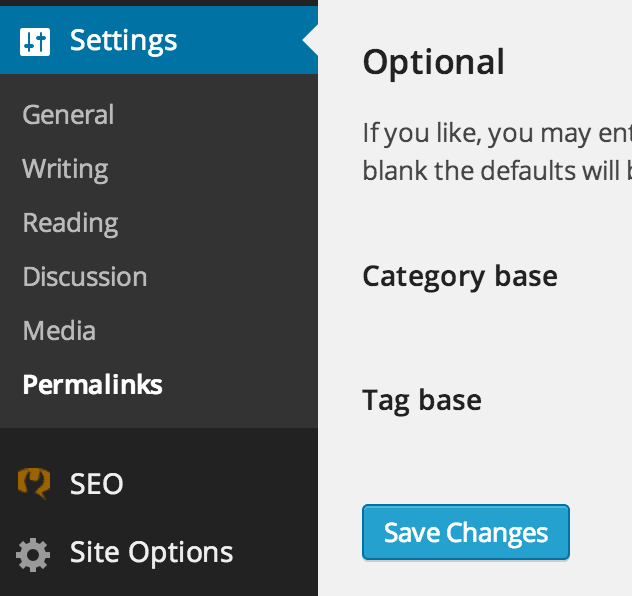Create a custom RSS feed for WordPress
Posted on | 2 minute read

Creating a custom RSS feed is pretty easy. I’ll show you have to do it in three steps. Here’s a pro-tip: browsers heavily cache RSS feeds. While developing, try using Incognito Mode.
1) Register the template
Place the following into functions.php
/**
* Register custom RSS feed.
*
* Note: This is registering a feed named, "custom".
*/
function grd_register_rss_feed() {
add_feed( 'custom', 'grd_get_custom_rss_template' );
}
add_action( 'after_setup_theme', 'grd_rss_template' );
/**
* Get the custom RSS template.
*
* Note: This is fetching a template part, named "feed-custom.php"
*/
function grd_get_custom_rss_template() {
get_template_part( 'feed', 'custom' );
}2) Create the template file
Create a new file, Name it feed-custom.php and place it inside your theme’s root directory.
<?php
/**
* Customs RSS template with related posts.
*
* Place this file in your theme's directory.
*
* @package sometheme
* @subpackage theme
*/
header( 'Content-Type: ' . feed_content_type( 'rss-http' ) . '; charset=' . get_option( 'blog_charset' ), true );
$frequency = 1; // Default '1'. The frequency of RSS updates within the update period.
$duration = 'hourly'; // Default 'hourly'. Accepts 'hourly', 'daily', 'weekly', 'monthly', 'yearly'.
$postlink = '<br /><a href="' . get_permalink() . '">See the rest of the story at mysite.com</a><br /><br />';
$email = get_the_author_meta( 'email');
$author = get_the_author();
$postimages = wp_get_attachment_image_src( get_post_thumbnail_id( get_the_ID() ), 'large' );
// Check for post image. If none, fallback to a default.
$postimage = ( $postimages ) ? $postimages[0] : get_stylesheet_directory_uri() . '/images/default.jpg';
echo '<?xml version="1.0" encoding="' . get_option( 'blog_charset' ) . '"?' . '>'; ?>
<rss version="2.0"
xmlns:content="http://purl.org/rss/1.0/modules/content/"
xmlns:wfw="http://wellformedweb.org/CommentAPI/"
xmlns:dc="http://purl.org/dc/elements/1.1/"
xmlns:atom="http://www.w3.org/2005/Atom"
xmlns:sy="http://purl.org/rss/1.0/modules/syndication/"
xmlns:slash="http://purl.org/rss/1.0/modules/slash/"
<?php do_action( 'rss2_ns' ); ?>
>
<!-- RSS feed defaults -->
<channel>
<title><?php bloginfo_rss( 'name' ); wp_title_rss(); ?></title>
<link><?php bloginfo_rss( 'url' ) ?></link>
<description><?php bloginfo_rss( 'description' ) ?></description>
<lastBuildDate><?php echo mysql2date( 'D, d M Y H:i:s +0000', get_lastpostmodified( 'GMT' ), false ); ?></lastBuildDate>
<language><?php bloginfo_rss( 'language' ); ?></language>
<sy:updatePeriod><?php echo apply_filters( 'rss_update_period', $duration ); ?></sy:updatePeriod>
<sy:updateFrequency><?php echo apply_filters( 'rss_update_frequency', $frequency ); ?></sy:updateFrequency>
<atom:link href="<?php self_link(); ?>" rel="self" type="application/rss+xml" />
<!-- Feed Logo (optional) -->
<image>
<url>https://mysite.com/somelogo.png</url>
<title>
<?php bloginfo_rss( 'description' ) ?>
</title>
<link><?php bloginfo_rss( 'url' ) ?></link>
</image>
<?php do_action( 'rss2_head' ); ?>
<!-- Start loop -->
<?php while( have_posts() ) : the_post(); ?>
<item>
<title><?php the_title_rss(); ?></title>
<link><?php the_permalink_rss(); ?></link>
<guid isPermaLink="false"><?php the_guid(); ?></guid>
<author><?php echo $email ?><?php echo ' (' . $author . ')' ?></author>
<image>
<url><?php echo esc_url( $postimage ); ?>"/></url>
</image>
<pubDate><?php echo mysql2date( 'D, d M Y H:i:s +0000', get_post_time( 'Y-m-d H:i:s', true ), false ); ?></pubDate>
<!-- Echo content and related posts -->
<content:encoded>
<![CDATA[<?php echo the_excerpt_rss(); echo $postlink; ?>]]>
</content:encoded>
</item>
<?php endwhile; ?>
<!-- End loop -->
</channel>
</rss>3) Flush Permalinks

Now your custom RSS feed can be found at
http://yoursite.com?feed=custom
Comments
No comments yet.
RSS FEED taking over Slug - Wordpress Helpdesk
[…] I followed this tutorial https://gregrickabyold.test/custom-rss-template-wordpress/ […]
Creating Custom WordPress RSS Feeds - WP RSS Aggregator
[…] Greg Rickaby – Custom RSS Template in WordPress […]
Raylo (@raylonet)
simple stuff that works, thanks for the help
Said Erraoudy
thanks alot bro (y) !
lettjacob
Thank you for taking the time to share this. Works great!
zaheerabbasaghani
Thank u very much
Saiful
It ‘s nice to do with custom Feeds.
Thanks a lot.
Tutorial: Help! My RSS Campaign is ugly and the preview is wrong.
[…] to Greg Rickaby for the alternative RSS template tutorial. You still have to read the code to change it to your […]
